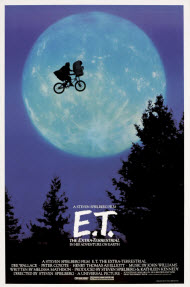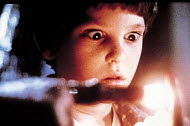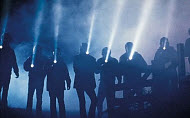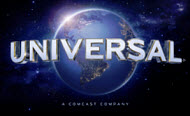E.T.: The Extra-Terrestrial
 for language and mild thematic elements.
for language and mild thematic elements.
Reviewed by: Ken Priebe
CONTRIBUTOR
| Moral Rating: | Better than Average |
| Moviemaking Quality: |
|
| Primary Audience: | Kids Family |
| Genre: | Sci-Fi Adventure Family Fantasy Drama |
| Length: | 1 hr. 55 min. |
| Year of Release: | 1982 |
| USA Release: |
June 11, 1982 (wide) |











Are we alone, or is there life elsewhere in the universe?
Did a “Martian” meteorite prove the existence of ET?
What does the Bible say about intelligent life on other planets?
Were the nephilim (sons of God) of Genesis 6:4 extraterrestrials?
Does Scripture refer to life in space?
Christ allegory
| Featuring |
|---|
|
Dee Wallace … Mary Henry Thomas … Elliott Peter Coyote … Keys Drew Barrymore … Gertie Robert MacNaughton … Michael K.C. Martel … Greg Sean Frye … Steve Tom Howell … Tyler Erika Eleniak … Pretty Girl David O'Dell … Schoolboy Richard Swingler … Science Teacher See all » |
| Director |
|
Steven Spielberg |
| Producer |
|
Universal Pictures Amblin Entertainment Kathleen Kennedy … producer Melissa Mathison … associate producer Steven Spielberg … producer |
| Distributor |
“He is afraid. He is totally alone. He is 3 million light years from home.”
In March 2002, the 20th Anniversary Edition of Steven Spielberg’s E.T. The Extra Terrestrial will be released in theaters for a whole new generation. Originally released on June 11, 1982, it is hailed as one of the defining movies of the 80s, and one of the biggest films of all time, both in profits and quality. Deleted scenes are going to be added, and special effects enhanced. It could likely regain its title as the highest grossing film; either way it will be a very special film event.
 Those of us who grew up watching the film as children are all familiar with the story: an alien botanist from outer space (originally named “Puck” by Spielberg but referred to as “E.T.”) is stranded on Earth and befriended by a 10-year-old boy named Elliott (Henry Thomas). With the help of his brother Michael (Robert MacNaughton) and sister Gertie (Drew Barrymore), he tries to keep him a secret from his mother (Dee Wallace) and all other adults. E.T. explores his Earthly surroundings with childlike curiosity, and stumbles upon a Buck Rogers comic strip that inspires him to try and contact his people in space, or as he puts it, “Phone home.” E.T. begins sharing his feelings psychically with Elliott, and the two become bonded. Eventually E.T. gets sick, possibly as a result of his people being far away, and dies. Elliott is heartbroken and expresses his love for his alien friend, and E.T. is miraculously resurrected. The film climaxes with a sky-high bicycle chase from the scientists and government officials who want E.T., and an emotional good-bye before the spaceship returns to take E.T. home at last.
Those of us who grew up watching the film as children are all familiar with the story: an alien botanist from outer space (originally named “Puck” by Spielberg but referred to as “E.T.”) is stranded on Earth and befriended by a 10-year-old boy named Elliott (Henry Thomas). With the help of his brother Michael (Robert MacNaughton) and sister Gertie (Drew Barrymore), he tries to keep him a secret from his mother (Dee Wallace) and all other adults. E.T. explores his Earthly surroundings with childlike curiosity, and stumbles upon a Buck Rogers comic strip that inspires him to try and contact his people in space, or as he puts it, “Phone home.” E.T. begins sharing his feelings psychically with Elliott, and the two become bonded. Eventually E.T. gets sick, possibly as a result of his people being far away, and dies. Elliott is heartbroken and expresses his love for his alien friend, and E.T. is miraculously resurrected. The film climaxes with a sky-high bicycle chase from the scientists and government officials who want E.T., and an emotional good-bye before the spaceship returns to take E.T. home at last.
Why is this film successful, and why has it triggered such an emotional response in audiences? Is it the special effects, the story, the music, the directing, the characters? Yes, it’s all of these things. As a film, it is technically and artistically superb. But I think E.T. speaks to us on another level, a deeper one in our subconscious and our souls. It deals with everyday emotions and experiences like broken families, loneliness, friendship, and love. It also points to a hunger we all have for a relationship with a being outside our world.
Novelist Martin Amis wrote of the film: “Towards the end of E.T., barely able to support my own grief and bewilderment, I turned and looked down the aisle at my fellow sufferers; executive, black dude, Japanese businessman, punk, hippie, mother, teenager, child. Each face was a mask of tears—And we weren’t crying for the little extraterrestrial, nor for little Elliott, nor for little Gertie. We were crying for our lost selves.” (p. 245, Steven Spielberg: the Unauthorized Biography by John Baxter.)
This powerful image points to the realization we all come to that despite all the riches of this world, even the riches of human relationships, we are all incredibly lonely. Spielberg’s films “Close Encounters of the Third Kind” and E.T. support the idea that we often look to the skies as a comfort and hope to fulfill this loneliness in our lives. The fact that we often perceive aliens in UFOs as being wiser, more advanced and more peaceful than we are indicates that we are aware of our own inadequacies and sinfulness. We admit that we need guidance and salvation from a source outside our worldly realm of perception. It even goes to the sad extreme of cults who believe that space aliens will come save them and take them to a celestial paradise.
The good news is that in reality this loneliness can be filled, not by space aliens, but by God, through His son Jesus Christ. There we find peace, purpose and that special relationship that we all ache for. The New Testament tells us how this relationship has been restored to us through the life, death and resurrection of Jesus. The film E.T. has many parallels to this story, which is part of the reason why it harbors the response it gets. It is questionable if any literal relation of E.T. as a Christ figure was deliberately intended by Spielberg or screenwriter Melissa Mathison. The story is more a reflection on Spielberg’s own lonely childhood. Spielberg, who is Jewish, had previously dealt with Biblical subject matter in “Raiders of the Lost Ark” a year earlier, and would later tell the Christ story brilliantly through the African slaves in “Amistad”. The indirect Christian parallels in E.T. are mostly accentuated through our subconscious mind without our even realizing it. This Jungian representation of “archetypes of the collective unconscious” gives us situations and images that echo the myths and historical gospels that have become part of our experience, in the same way that the myth and history references in films like Star Wars enhance our connection and involvement.
Persecution
When E.T. first arrives on Earth, he is immediately pursued and hunted by a team of scientists who may want to harm him. Shortly after Jesus was born he was pursued by King Herod, who ordered all two-year old boys to be killed so the Messiah would not threaten his leadership. He originally sent the three wise Magi to find the Christ child and report back to him to he could worship him. The Magi and Joseph were warned in a dream that worship was not Herod’s intention, so Jesus was taken to hide in Egypt. (Matthew 2:1-18) In E.T., it is not three wise men but three children who assist in hiding E.T. from the scientists.
Family
 10-year-old Elliott is the middle child, too young to hang out with his older brother Michael and too old to play with his little sister Gertie. Their mother is separated from their father, who is in Mexico with another woman. There is an air of resentment and distance between Elliott and his mother, as if he blames her for his father leaving. When he first sees E.T. in his backyard, nobody believes him, and he comments that his father would have. The broken family is a situation that all too many of us can relate to, and it serves as an effective backdrop to set up the bond between Elliott and E.T. The absence of a father in his life deepens the gap that is filled by E.T. as a sort of “heavenly father” or friend.
10-year-old Elliott is the middle child, too young to hang out with his older brother Michael and too old to play with his little sister Gertie. Their mother is separated from their father, who is in Mexico with another woman. There is an air of resentment and distance between Elliott and his mother, as if he blames her for his father leaving. When he first sees E.T. in his backyard, nobody believes him, and he comments that his father would have. The broken family is a situation that all too many of us can relate to, and it serves as an effective backdrop to set up the bond between Elliott and E.T. The absence of a father in his life deepens the gap that is filled by E.T. as a sort of “heavenly father” or friend.
Children
E.T. is brought into the home and hidden by Elliott. He introduces him to his siblings and makes them promise to keep him a secret. He knows that if any adults find him, he will be handed over to the authorities, who will “do tests on him or give him a lobotomy or something.” Although E.T. is actually 900 years old (much like many people in the Old Testament), he explores his surroundings with the innocence and curiosity of a child, which makes him an ideal pupil for the human children who welcome and protect him. “Whoever welcomes one of these little children in my name welcomes me” Mark 9:37. Spielberg accentuates this perspective by shooting most of the film in low angle shots, as if being seen from a child’s eye-view.
“I tell you the truth, unless you change and become like little children, you will never enter the kingdom of God.”
—Matthew 18:3Elliott (to Gertie): “Grown-ups can’t see him, only little kids can see him.”
“I wanted to have children after making E.T.”
—Steven Spielberg
Salvation/Exodus
 Elliott and E.T. begin sharing feelings telepathically, which results in some hilarious scenes. While E.T. is at home, slightly inebriated, Elliott is dissecting frogs in science class. The frogs remind him of E.T. When E.T. finds a comic strip that inspires him to contact his spaceship, Elliott is inspired to save the frogs from their fate. He realizes again that E.T. will possibly be dissected as well, unless they find a way to get him back home. At this point in the film, both the science teacher and the scientists who are searching for E.T. never show their faces. We only see their hands, feet or anything else besides their faces. This stylistic decision dehumanizes them and makes them seem more threatening, and further emphasizes seeing the film from a child’s perspective. Just as “only kids can see E.T.,” with the exception of Elliott’s mother so far the audience can only see kids. Elliott frees the frogs from their jars and they swarm the classroom, in a chaotic scenario that echoes the plague of frogs from the book of Exodus, represented visually in another Spielberg production, “The Prince of Egypt”. In this case, it is an exodus for the frogs!
Elliott and E.T. begin sharing feelings telepathically, which results in some hilarious scenes. While E.T. is at home, slightly inebriated, Elliott is dissecting frogs in science class. The frogs remind him of E.T. When E.T. finds a comic strip that inspires him to contact his spaceship, Elliott is inspired to save the frogs from their fate. He realizes again that E.T. will possibly be dissected as well, unless they find a way to get him back home. At this point in the film, both the science teacher and the scientists who are searching for E.T. never show their faces. We only see their hands, feet or anything else besides their faces. This stylistic decision dehumanizes them and makes them seem more threatening, and further emphasizes seeing the film from a child’s perspective. Just as “only kids can see E.T.,” with the exception of Elliott’s mother so far the audience can only see kids. Elliott frees the frogs from their jars and they swarm the classroom, in a chaotic scenario that echoes the plague of frogs from the book of Exodus, represented visually in another Spielberg production, “The Prince of Egypt”. In this case, it is an exodus for the frogs!
Inside information
One of the deleted scenes that will most likely be put back into the film features Harrison Ford as Elliott’s school principal.
In the scene where Mom comes home with Gertie and E.T. is stumbling around the kitchen, Mom opens the refrigerator door, hitting E.T. and making him fall over. This was not in the script; it was an accident that happened as they were shooting the scene, and it was so funny Spielberg left it in!
Words
As E.T. learns human language by watching Sesame Street, the first sentence he says is “Be good,” which almost sums up the entire Sermon on the Mount into two words!
Healing
As Elliott and E.T. gather supplies to build a radio for contacting the spaceship, Elliott cuts his finger on a saw blade. E.T. touches Elliott’s finger with his, and the cut is completely healed.
“And one of them (Jesus’ followers) struck the servant of the high priest, cutting off his right ear. But Jesus answered, “No more of this!” And he touched the man’s ear and healed him.”
—Luke 22:50-51
Jesus healed many people in his Earthly ministry, and He still heals people today. The image of E.T. and Elliot’s fingers touching that was used in the movie advertising also bears a strong resemblance to the fingers of God and Adam in Michelangelo’s Creation of Man.
Salvation/Faith
In a tender scene that sums up one of the many themes and inspirations of the film, Elliott and E.T. hide in the closet, listening to their mother tell Gertie a bedtime story. The story is Peter Pan, in the scene where Peter realizes that Tinkerbell drank poison in order to save his life. In the original stage play of this story, in order to save Tinkerbell, the audience had to clap their hands and say they believed in fairies. Gertie and her mother clap their hands as they read the story, saying that they believe in fairies, as Elliott and E.T. listen and embrace. The idea of sacrificing one’s life to save another, as Tinkerbell did for Peter Pan, parallels the sacrifice of Jesus on the cross to save mankind, which requires from us a response in belief and faith.
The famous image of Elliott and E.T. riding on a bike across the moon is an homage to the final scene of Disney’s version of Peter Pan (1953), where the pirate ship-cloud sails across the moon. Again, the context of that scene being one of looking at the world with a childlike innocence, as the Darling family gazes into the sky, dreaming of Neverland. Peter Pan had a lasting influence on Spielberg, and he revisited it more fully in 1991 with “Hook”.
Home
In the forest, Elliott and E.T. set up their radio and send messages into space. It begins to work, and E.T. repeats the word, “Home.” Like Christians, E.T. is presently “in the world, but not of the world.” We refer to Heaven as our “home,” and long for the day when God takes us there. Prayer is, in a sense, “phoning home.”
Death
Living on Earth and being far from home, E.T. becomes deathly ill, and because Elliott shares what he feels, so does he. The situation becomes so grim that the children break their silence and reveal E.T. to their mother. At first she thinks E.T. is fake, but when he reaches out to her and cries out, “Mooooom…”, she realizes that E.T. is very real. Oddly enough, the mother’s name is Mary, who of course is the mother of Jesus. There is a touching scene where E.T. gazes lovingly and helplessly at Mary as he lays on his deathbed, just as Jesus looked at his mother while on the cross.
 The entire house is quarantined as the government and science steps in. Elliott and E.T. are hooked up to machines and Elliott protests that he can take care of him, reassuring his friend, “I’ll be right here.” One of the scientists (Peter Coyote), a man only referred to as “Keys” because of the many keys he carries on his belt, finally reveals his face as he speaks to Elliott. He tries to ask him questions about the radio. Elliott, in his sickness, is reluctant to tell him his secrets, insisting, “He came to me.” Keys replies, “Elliott, he came to me too.
The entire house is quarantined as the government and science steps in. Elliott and E.T. are hooked up to machines and Elliott protests that he can take care of him, reassuring his friend, “I’ll be right here.” One of the scientists (Peter Coyote), a man only referred to as “Keys” because of the many keys he carries on his belt, finally reveals his face as he speaks to Elliott. He tries to ask him questions about the radio. Elliott, in his sickness, is reluctant to tell him his secrets, insisting, “He came to me.” Keys replies, “Elliott, he came to me too.
I’ve been wishing for this since I was 10 years old.” Indeed, Jesus came for all of us to save us from our sin, as had been prophecied for several hundred years. Keys goes on to say “His being here is a miracle.” It was through the “miracles” of the virgin birth and the resurrection that Jesus came to be here with us.
As E.T.’s life drains away, Elliott’s life comes back. E.T. sacrifices his life for his human friend.
Resurrection
Elliott peers into the coffin where E.T. lies and says good-bye. In response to saving him, as Tinkerbell did for Peter Pan, he tells him “I’ll believe in you all my life.” As he closes the coffin lid, E.T.’s heart light comes back, a sign that his people are coming back for him. At the beginning of the film, when the spaceship leaves, E.T.’s heart light fades and doesn’t appear again until this moment. Elliott rejoices in the resurrection of his friend, and tells his brother, “He’s alive! He’s alive!”
“Mary Magdalene went to the disciples with the news: ‘I have seen the Lord!’”
—John 20:18
Michael and Elliott steal a van with E.T. inside, and meet Michael’s friends at the playground. Previously in the film, his friends openly ridiculed Elliott concerning his imaginary “goblin”; their mouths are silenced as they approach the back of the van and see E.T. alive and dressed in a white robe. At the Mount of Transfiguration, Jesus was revealed temporarily in his full glory, as he would be at his resurrection, and his robe shone a brilliant white light. (Mark 9:2-12, Matthew 17:1-13) Michael’s friends, the former Doubting Thomases, come face-to-face with the being they always secretly wished was real and believed in.
Ascension
Elliott’s family, along with Keys and Michael’s friends, meet in the forest where the spaceship lands, and say good-bye to E.T. He tells Michael, “Thank you.” He tells Gertie, “Be good.” After a touching embrace with Elliott, E.T.’s finger lights up and he touches Elliott’s forehead, reassuring him “I’ll be right here.”
“And surely I am with you always, to the very end of the age.”
—Matthew 28:20
The finger touch on the forehead was Steven Spielberg’s way showing his approval to his friends and colleagues. Tying it to the Christian interpretation, “I’ll be right here” reminds us that Jesus is not only present in our hearts through the Holy Spirit, but also in our minds as He changes us to be more like Him.
“Be transformed by the renewing of your mind.”
—Romans 12:2
E.T. enters his spaceship and “ascends into Heaven” as Jesus did, leaving a rainbow in the night sky. After the Great Flood, the rainbow was a sign by God of the everlasting covenant He had established with his creation.
“Whenever the rainbow appears in the clouds, I will see it and remember the everlasting covenant between God and all living creatures of every kind on the earth.”
—Genesis 9:16
In E.T., the “covenant” is one of love, friendship and sacrifice between two worlds, remarkably similar and relevant to our relationship with God through Jesus Christ. The innocence of childhood, the loneliness of man and the risk of sacrificial love are all universal truths that make E.T. The Extra Terrestrial a powerful, emotional and spiritual film experience.
Editors note: The reviewer is not saying that E.T. is like Jesus (the very Son of God), but rather to point out some unique similarities included in the film that, if appropriately addressed, could be valuable in leading a discussion with those who may be interested in Jesus’ message of salvation.
See list of Relevant Issues—questions-and-answers.


[5]
[Better than Average / 5]
[Average / 5]
[Very Offensive / 1½]
[Very Offensive / 2]
[Good / 4½]



